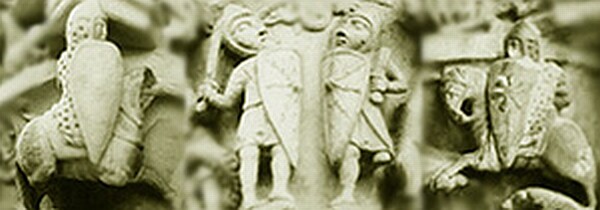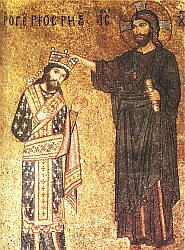|
|
|
|
|
|
|

|
This essay is going to cover the Norman Conquest. "But Kali," you say, "we
thought that 1066 was the one thing these essays explicitly wouldn't
cover." To which I reply, "Not that Norman Conquest, this
Norman Conquest." Let's face it, these descendants of the Vikings were
just very conquering guys.
The Duchy of Normandy was created in 911, when Charles the Simple of France made the Viking chieftain Hrolf the Ganger a royal vassal, giving him as a fief the lands along the coast which the Vikings already in fact occupied. (And that's a cute story in its own right, for another time.) But after a few generations of settled life there were still too many restless, landless, bloodthirsty young men who needed an outlet for their ambitions. In the early 11th century, bands of young Normans went south to earn money doing what they did best - war. They headed to the boot of Italy, not just for the sunshine but because it was a great market for mercenaries: Lombard princes were fighting for their independence against the still powerful Byzantine Empire, the Papacy and the Holy Roman Empire were trying separately to extend influence southwards, and Saracen pirates raided everybody from their bases in Sicily and northern Africa. The Normans arrived in 1017 and made themselves available. At one point or another they fought for almost every side in this power struggle, and they always managed to be on the winning side - sometimes by their shrewdness in judging the odds correctly, sometimes by their own prowess at arms being decisive, and sometimes simply by there being Normans fighting on both sides. Their power and influence began to grow significantly, and as they were granted titles to land (when their employers couldn't pay cash) they became players in their own right. In 1046, one of the great players arrived: Robert, sixth son of Tancred of Hauteville. (The Hautevilles were an archetype of the population pressure that sent ambitious young Normans south: Tancred had 12 sons and at least three daughters by two marriages. Five of the sons became counts and dukes in Italy, and their descendants became kings.) Called Guiscard, "the Crafty," Robert was a blond, blue-eyed giant, "taller than the tallest," who took to power politics like a natural. At first kept firmly subordinate to his senior brothers and other predecessors, within 11 years Robert became the most powerful of the Norman leaders by means of his charm, cunning, and aggressiveness. (Robert only just missed the other giant, cunning power-politician of the 11th century, Harald Hardradi of Norway, who had been fighting for the Byzantines in Sicily until 1041.) As the Byzantines, Lombards, and popes began to realize what was happening, the wars gradually became alliances of everyone else against the northern newcomers, but the Normans kept on winning. By 1066 (while their cousins in the north were busy doing something or other), the Normans in southern Italy had become the dominant power in the region. Richard of Aversa was Prince of Capua, ruler of the west coast; Robert Guiscard was Duke of Apulia, overlord of the east coast and the foot; and Robert's younger brother Count Roger was slowly conquering Sicily from the Saracen Kalbids. In 1081, Robert Guiscard's success and ambition brought him to take the offensive against the Byzantine Empire beyond the Italian peninsula: he invaded across the Adriatic and besieged the city of Durazzo. The Emperor Alexius Comnenus himself led the army that marched to meet the Normans, and when the Emperor was with the army in the field, the Varangian Guard went with him. The Guard was, as always, made up of North Europeans, originally Scandinavians but at that time mostly Saxons who had fled England after the Conquest - and here they found themselves fighting Normans again, 15 years after Hastings. If they relished the prospect of a rematch, they weren't careful enough what they wished for because that's what they got. The Norman cavalry turned and rode away (either a feigned retreat or a real one, it's not completely clear for either battle), the Saxon infantry broke formation to pursue them, and the Norman counterattack chewed them up. Although the battle was a victory for Guiscard, troubles at home took him back to Italy, where he died four years later. When the First Crusade got underway in 1096, a major contingent came from Norman Italy - perhaps things were getting too settled there, and once again rowdy and ambitious youths needed somewhere to go to find an outlet. The leader of the Italian contingent was Bohemund, son of Robert Guiscard, who inherited his father's height and good looks in plenty but little else. He was Robert's son from his first, annulled marriage, so (like most knights of the First Crusade) he had no patrimony at home and set out to find his own. He found it when he captured Antioch, the greatest city in Syria - at one time the third greatest city in the Roman Empire, after Constantinople and Alexandria - and his successors made it into a wealthy and cosmopolitan state. Meanwhile back in Italy, things continued after the death of Robert Guiscard. The conquest of Sicily from the Saracens was completed in 1091; Count Roger II of Sicily united all Norman territories in Italy under his rule in 1128, and took the title of King in 1130. The new Kingdom of Sicily was fantastically rich: Roger II's income from Palermo alone reputedly exceeded what his Norman cousins collected from all England. The kingdom boasted a flourishing culture that combined Byzantine, Arabic, and western European elements, especially in art and architecture. |
 Roger II crowned by Christ |
 Rose Window of San Giovanni |
|
And so, at the height of the 12th century, Normans (or descendants of Normans) ruled not only England and half of France, and the wealthiest Crusader state in Outremer as well, but also a prosperous, powerful, and strongly centralized state in the middle of the Mediterranean world.
In 1197, three-year-old Frederick II of Hohenstaufen inherited the Kingdom of Sicily from his mother Constance, and the Holy Roman Empire from his father Henry VI. When he came of age, Frederick undertook a long and ultimately fruitless struggle to make the Empire a strong, centralized state and to bring all Italy into it; in those 30 years, he drew on the strength and wealth of his southern kingdom as his power base, and the country suffered as a result. After Frederick's death, southern Italy was conquered by France to make a kingdom for Louis IX's younger brother; after the French, it was taken over by Aragon. Each time the region became subordinate to a larger European power, its wealth and its culture declined, and so the Norman achievement was finally lost and forgotten.
|
|
In the Current Middle Ages A recurring theme of these essays is that it's wrong for us - for us, especially - to view medieval history through hindsight. Rather, we should seek to see it from within, as people at the time saw it: not as "history" but as "what's going on." Because the Kingdom of Sicily disappeared by 1250, while the heirs of William the Conqueror still rule England to this day, the Italian kingdom is now a forgotten dead end. But which was more significant at the time? William just took over a kingdom, kicking out the old ruling class and replacing them with his croneys; the Normans in Italy created a rich and powerful state where there had been none before. William fought one set-piece battle and put down a number of revolts; the Normans in Italy spent a hundred years out-fighting and out-politicking Byzantines, Popes, Holy Roman Emperors, Lombard princes, Saracen pirates, and Kalbid emirs. Which should be remembered as "the" Norman Conquest? William married one daughter to his buddy the Duke of Brittany, and one to his vassal the Count of Blois (the other four took the veil or died young); Roger I of Sicily married one daughter to the King of Hungary and another to the son of the Holy Roman Emperor. In the world of political/dynastic marriages, which Norman was the more influential father-in-law among the Powers That Were?
|
|
Further Reading The Norman conquest of southern Italy was a major turning point in the history of the region. Before the Normans arrived, the region was at least as fragmented as the north; after the conquest, and even when its power and importance later declined, it remained politically centralized - independent communes became the most common form of government in northern Italy, but never in the south. As such a major event, it always rates a chapter in any history of the region - for example, A History of Sicily, by M.I. Finley, Denis Mack Smith, and Christopher Duggan (1987; abridged from a three-volume 1968 work). For whole books on the subject, the classic texts are The Norman Achievement: 1050-1100 (1969) and The Norman Fate: 1100-1154 (1976) by David C. Douglas, scholarly yet quite readable. Even more definitive is Donald Matthew's The Norman Kingdom of Sicily (1992) of the Cambridge Medieval Textbook series, but at over 400 pages it may be a bit intimidating to some people. For a quick, light overview of the Normans "back home," there's a chapter on Normandy pre-1066 in David Howarth's 1066: the year of the conquest (1977). |
|
|
| text copyright 1999 by Caleb Hanson (e-mail) |
Home |
Usage |
Forums |
Articles |
Patterns |
Graphics |
Extras |
Contact Us


|